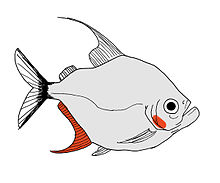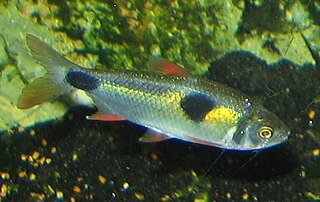
Lepidophagy is a specialised feeding behaviour in fish that involves eating the scales of other fish. Lepidophagy is widespread, having evolved independently in at least five freshwater families and seven marine families. A related feeding behavior among fish is pterygophagy: feeding on the fins of other fish.
Hisonotus is a genus of armored catfishes native to South America. Species of Hisonotus and Curculionichthys are the only representatives of the subfamily Otothyrinae having serrae on the posterior edge of the pectoral fin spine. These species are small fishes, generally found in small fast flowing streams, where they grasp to the branches and leaves of aquatic or subaquatic plants. The species of this genus mostly occur in Atlantic coastal streams of southern Brazil and the Paraguay-Paraná system of southern South America. They are also distributed in the Río de La Plata basin and coastal rivers of southeastern Brazil.

Parotocinclus is a genus of fish in the family Loricariidae native to South America. This genus is distributed through almost all hydrographic systems in South America from the Guyana Shield drainages and Amazon Shield tributaries to the coastal drainages of eastern and southeastern Brazil, including the rio São Francisco basin. Most species have the caudal peduncle oval in cross section. It has been found that Characidium species may interact with P. maculicauda. The small Characidium will follow grazing P. maculicauda, which release particulate matter dislodged from the catfish's foraging.
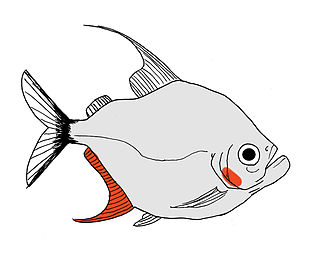
The wimple piranha, Catoprion mento, is a specialized, South American species of piranha that feeds on fish scales. There is debates over whether or not this species is considered a true piranha. If considered a true piranha, it would be the smallest species in the world.
Opisthopatus is a genus of South African velvet worms in the family Peripatopsidae. The number of legs in this genus range from 16 pairs to 18 pairs. Mothers in this genus give birth to live young. In particular, this genus exhibits matrotrophic viviparity, that is, mothers in this genus retain eggs in their uteri and supply nourishment to their embryos, but without any placenta.
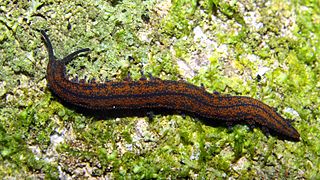
Peripatoides is a genus of velvet worms in the family Peripatopsidae, whose species are found in New Zealand. Like all velvet worms, these animals are nocturnal hunters that spit glue to trap their prey. Species of Peripatoides have 14, 15 or 16 pairs of legs. This genus exhibits lecithotrophic ovoviviparity; that is, mothers in this genus produce and retain yolky eggs in their uteri. The eggs are fertilized internally, and babies develop inside their mother until large enough to be born, in batches of 4-6, as colourless miniatures of the parents. These live-bearing Peripatoides have dermal-haemocoelic sperm transfer - which means sperm dissolve holes in the skin of the female to enter the body (haemolymph) anywhere on the body wall of the female.

Peripatopsis is a genus of South African velvet worms in the Peripatopsidae family. The number of legs in this genus ranges from as few as 16 pairs to as many as 25 pairs and varies within species when the number is greater than 18 pairs. Velvet worms in this genus feature a last pair of legs that is rudimentary or reduced in size, mainly in males. This genus exhibits matrotrophic viviparity, that is, mothers in this genus retain eggs in their uteri and supply nourishment to their embryos, but without any placenta.

Peripatidae is a family of velvet worms. The oldest putative representatives of the family herald from Burmese amber dated to the mid-Cretaceous, around 100 Ma, with representatives from Dominican and Baltic amber attesting to a broader distribution in the Palaeogene / Neogene; molecular variability suggests that the family's crown group may have arisen in the early Mesozoic.

Peripatopsidae is one of the two living velvet worm families.
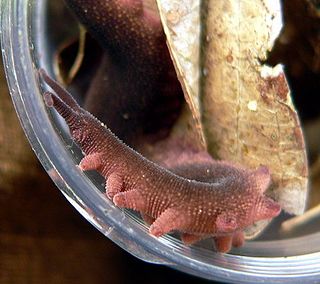
Eoperipatus is a Southeast Asian genus of velvet worm in the family Peripatidae. The number of legs in this genus varies within species as well as among species and ranges from 22 pairs to 25 pairs. This genus exhibits lecithotrophic ovoviviparity; that is, mothers in this genus retain yolky eggs in their uteri.
Heteroperipatus is a genus of Central American velvet worms in the Peripatidae family. The number of legs in this genus varies within species as well as among species and ranges from 26 pairs to 32 pairs. This genus is viviparous, with mothers supplying nourishment to their embryos through a placenta.
Curimatopsis is a genus of small South American fish in the family Curimatidae. They are native to freshwater habitats in the Amazon, Orinoco and Paraguay basins, as well as river of the Guianas.

Ooperipatellus is a genus of Australian and New Zealand velvet worms in the Peripatopsidae family. Species in this genus are oviparous. Most species in this genus have 14 pairs of legs, but O. nanus has only 13 pairs, which is the minimum number found in the phylum Onychophora. Velvet worms in this genus are among the smallest known, with adults often only 10 to 20 millimeters long. Morphological and molecular data indicate that this genus is a monophyletic group.
Epiperipatus vagans is a species of velvet worm in the Peripatidae family. The male of this species has 29 or 30 pairs of legs; females have 32 or 33. The type locality is in Panama.

Epiperipatus edwardsii is a species of velvet worm in the Peripatidae family. Females of this species have 29 to 34 pairs of legs; males have 28 to 30. Females range from 23 mm to 56 mm in length, whereas males range from 25 mm to 30 mm. The type locality is in French Guiana.
Opisthopatus cinctipes is a species of velvet worm in the Peripatopsidae family. This species has 16 pairs of legs, all with claws and all used for walking. The color of the dorsal surface varies from blue to olive green. Females range from 7 mm to 50 mm in length, whereas males range from 6 mm to 36 mm. Like other velvet worms in this genus, this species exhibits matrotrophic viviparity, that is, mothers in this genus retain eggs in their uteri and supply nourishment to their embryos, but without any placenta. The type locality is in South Africa.
Heteroperipatus clarki is a species of velvet worm in the Peripatidae family. Females of this species have 26 to 29 pairs of legs. The original description of this species is based on a female specimen measuring 100 mm in length. The type locality is in Panama.
Peripatus ruber is a species of velvet worm in the Peripatidae family. This species has 30 pairs of legs. The type locality is in Costa Rica.
Mongeperipatus solorzanoi, or Solórzano's velvet worm, is a species of velvet worm in the Peripatidae family. Like other neotropical peripatid velvet worms, this species is viviparous, with mothers supplying nourishment to their embryos through a placenta.
